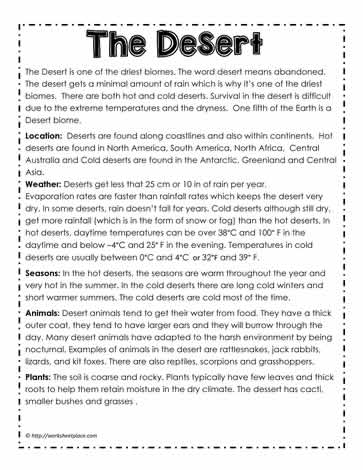| |||||
| Desert Biome Information and Facts For Google Apps | |||||
| The Desert is one of the driest biomes. The word desert means abandoned. The desert gets a minimal amount of rain which is why it’s one of the driest biomes. There are both hot and cold deserts. Survival in the desert is difficult due to the extreme temperatures and the dryness. One fifth of the Earth is a Desert biome. Location: Deserts are found along coastlines and also within continents. Hot deserts are found in North America, South America, North Africa, Central Australia and Cold deserts are found in the Antarctic, Greenland and Central Asia. Weather: Deserts get less that 25 cm or 10 in of rain per year. Evaporation rates are faster than rainfall rates which keeps the desert very dry. In some deserts, rain doesn’t fall for years. Cold deserts although still dry, get more rainfall (which is in the form of snow or fog) than the hot deserts. In hot deserts, daytime temperatures can be over 38 Degrees C and 100 Degrees F in the daytime and below –4 Degrees C and 25 Degrees F in the evening. Temperatures in cold deserts are usually between 0 Degrees C and 4 Degrees C or 32°F and 39 Degrees F. Seasons: In the hot deserts, the seasons are warm throughout the year and very hot in the summer. In the cold deserts there are long cold winters and short warmer summers. The cold deserts are cold most of the time. Animals: Desert animals tend to get their water from food. They have a thick outer coats, they tend to have larger ears and they will burrow through the day. Many desert animal have adapted to this harsh environment by being nocturnal. Examples of animals in the desert are rattlesnakes, jack rabbits, lizards, and kit foxes. There are also reptiles, scorpions and grasshoppers. Plants: The soil is coarse and rocky. Plants typically have few leaves and thick roots to help them retain moisture in the dry climate. The dessert has cacti, smaller bushes and grasses . | |||||

All worksheets are created by experienced and qualified teachers. Send your suggestions or comments.